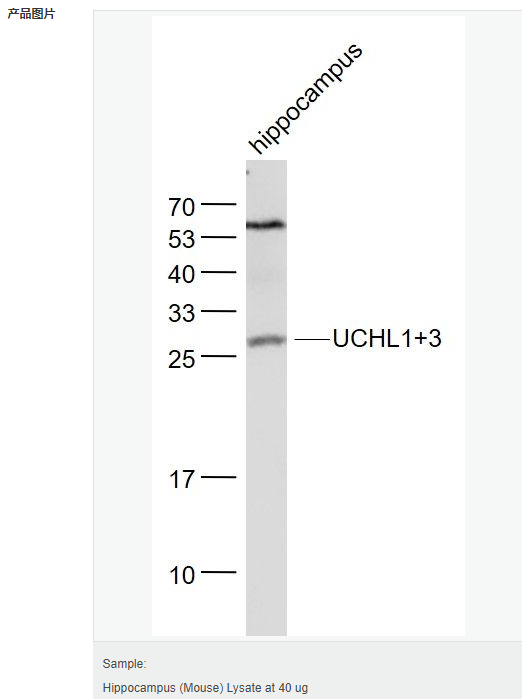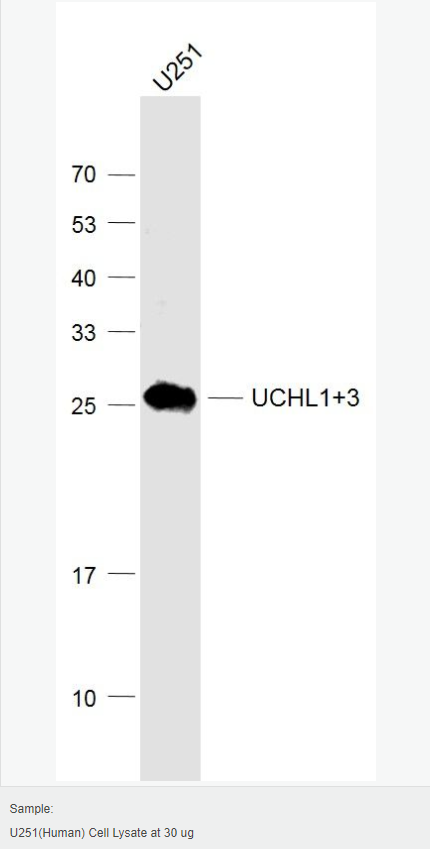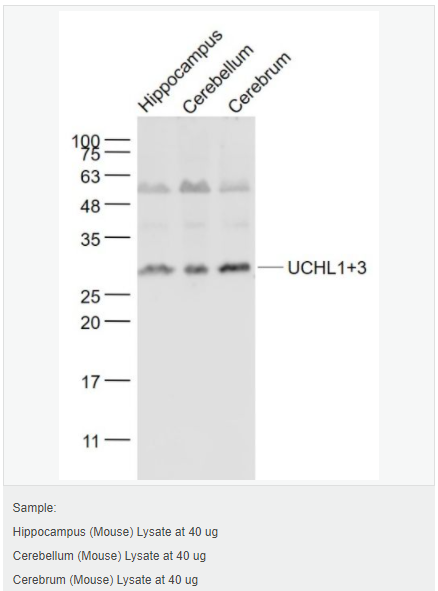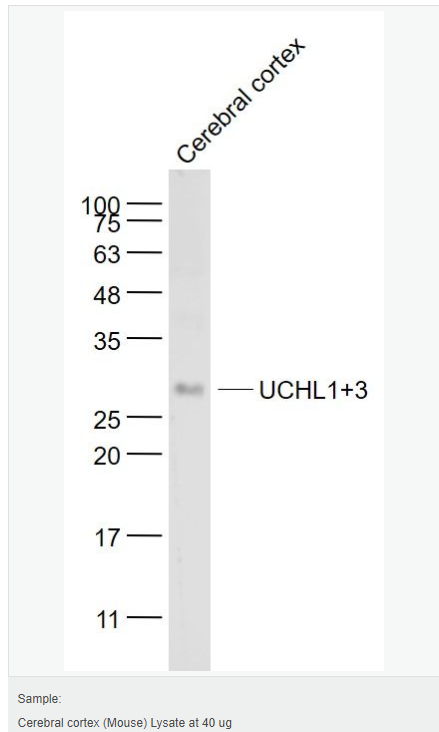

貨號
產(chǎn)品規(guī)格
售價
備注
BN40324R-100ul
100ul
¥2360.00
交叉反應:Human,Mouse(predicted:Rat,Dog,Pig,Horse,Rabbit,Sheep) 推薦應用:WB,IHC-P,IHC-F,ICC,IF,ELISA
BN40324R-200ul
200ul
¥3490.00
交叉反應:Human,Mouse(predicted:Rat,Dog,Pig,Horse,Rabbit,Sheep) 推薦應用:WB,IHC-P,IHC-F,ICC,IF,ELISA
產(chǎn)品描述
| 英文名稱 | UCHL1+3 |
| 中文名稱 | 泛素硫酯酶L1+3抗體 |
| 別 名 | Epididymis luminal protein 117; Epididymis secretory protein Li 53; HEL 117; HEL S 53; NDGOA; Neuron cytoplasmic protein 9.5; OTTHUMP00000218137; OTTHUMP00000218139; OTTHUMP00000218140; OTTHUMP00000218141; Park 5; PARK5; PGP 9.5; PGP9.5; PGP95; Protein gene product 9.5; Ubiquitin C terminal esterase L1; Ubiquitin C terminal hydrolase; Ubiquitin C terminal hydrolase L1; Ubiquitin carboxyl terminal esterase L1; Ubiquitin carboxyl terminal hydrolase isozyme L1; Ubiquitin carboxyl-terminal hydrolase isozyme L1; Ubiquitin thioesterase L1; Ubiquitin thiolesterase; Ubiquitin thiolesterase L1; UCH-L1; UCHL1; UCHL1_HUMAN. |
| 研究領域 | 細胞生物 神經(jīng)生物學 細胞類型標志物 泛素 |
| 抗體來源 | Rabbit |
| 克隆類型 | Polyclonal |
| 交叉反應 | Human, Mouse, (predicted: Rat, Dog, Pig, Horse, Rabbit, Sheep, ) |
| 產(chǎn)品應用 | WB=1:500-2000 ELISA=1:5000-10000 IHC-P=1:100-500 IHC-F=1:100-500 ICC=1:100-500 IF=1:100-500 (石蠟切片需做抗原修復) not yet tested in other applications. optimal dilutions/concentrations should be determined by the end user. |
| 分 子 量 | 25kDa |
| 細胞定位 | 細胞漿 細胞膜 |
| 性 狀 | Liquid |
| 濃 度 | 1mg/ml |
| 免 疫 原 | KLH conjugated synthetic peptide derived from human UCHL1+3:141-223/223 |
| 亞 型 | IgG |
| 純化方法 | affinity purified by Protein A |
| 儲 存 液 | 0.01M TBS(pH7.4) with 1% BSA, 0.03% Proclin300 and 50% Glycerol. |
| 保存條件 | Shipped at 4℃. Store at -20 °C for one year. Avoid repeated freeze/thaw cycles. |
| PubMed | PubMed |
| 產(chǎn)品介紹 | The two ubiquitin C-terminal hydrolase (UCH) enzymes, UCHL1 and UCHL3, deubiquitinate ubiquitin-protein conjugates and control the cellular balance of ubiquitin. UCHL1 and UCHL3 are both small proteins of ~220 amino acids that share more than 40% amino acid sequence identity. UCHL3 is universally expressed in all tissues, while UCHL1 is expressed exclusively in neuronal tissue, testis and ovary. The activity of UCHL3 is more than 200 fold higher than UCHL1 when a fluorogenic ubiquitin substrate is used. UCHL1 associates with monoubiquitin and UCHL3 binds to Nedd8, ubiquitin-like protein. UCHL1 and UCHL3 play a role in the regulation of neuronal development and spermatogenesis. UCHL1 is involved in the pathogenesis of Parkinson’s disease (PD) and Alzheimer’s disease (AD). Function: Ubiquitin-protein hydrolase involved both in the processing of ubiquitin precursors and of ubiquitinated proteins. This enzyme is a thiol protease that recognizes and hydrolyzes a peptide bond at the C-terminal glycine of ubiquitin. Also binds to free monoubiquitin and may prevent its degradation in lysosomes. The homodimer may have ATP-independent ubiquitin ligase activity. Subunit: Monomer. Homodimer. Interacts with SNCA (By similarity). Interacts with COPS5. Subcellular Location: Cytoplasm. Endoplasmic reticulum membrane; Lipid-anchor. Note=About 30% of total UCHL1 is associated with membranes in brain. Tissue Specificity: Found in neuronal cell bodies and processes throughout the neocortex (at protein level). Expressed in neurons and cells of the diffuse neuroendocrine system and their tumors. Weakly expressed in ovary. Down-regulated in brains from Parkinson disease and Alzheimer disease patients. Post-translational modifications: O-glycosylated DISEASE: Defects in UCHL1 are the cause of Parkinson disease type 5 (PARK5) [MIM:613643]; also known as Parkinson disease autosomal dominant 5. PARK5 is a complex neurodegenerative disorder with manifestations ranging from typical Parkinson disease to dementia with Lewy bodies. Clinical features include parkinsonian symptoms (resting tremor, rigidity, postural instability and bradykinesia), dementia, diffuse Lewy body pathology, autonomic dysfunction, hallucinations and paranoia. Similarity: Belongs to the peptidase C12 family. SWISS: P09936 Gene ID: 7345 Database links: Entrez Gene: 7345 Human Entrez Gene: 22223 Mouse Entrez Gene: 101117250 Sheep Omim: 191342 Human SwissProt: P09936 Human SwissProt: Q9R0P9 Mouse Unigene: 518731 Human Unigene: 29807 Mouse Unigene: 107213 Rat Important Note: This product as supplied is intended for research use only, not for use in human, therapeutic or diagnostic applications. |



